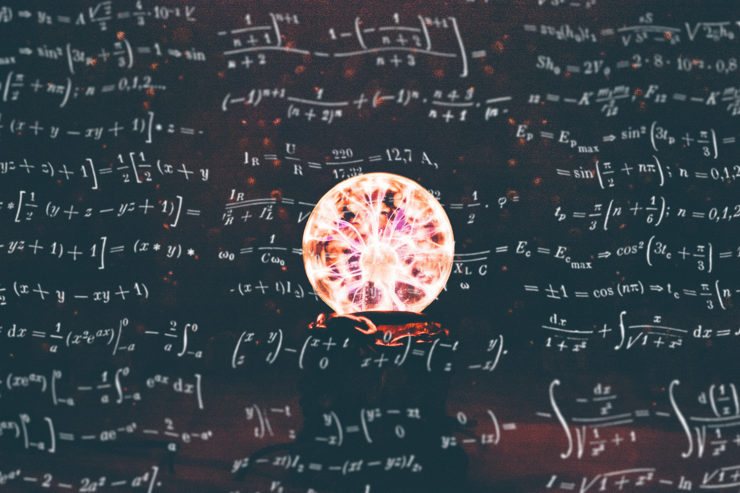In literature, magic is often grouped into three main categories—illusion (sleight of hand), spells and alterations of reality (paranormal), and the fantastic—and thus hidden there. Meantime, the word “magic” can itself shift from noun to verb to adjective and back again, an utterance repeatedly revealed as having a transformative property all its own.
I say “hidden” and “revealed” because the divvying up of magic into component parts keeps the whole of its complex nature somewhat safe from discovery. The act of defining magic becomes a way of constraining it, and of protecting it—and us. In some ways, magic becomes its own protective ward against wanting something so powerful that it can alter reality in the nick of time—shazaam!—so that we might use it to save the things we love.
Math, on the other hand. Math is different.
Math has its origins in the love of learning. Math’s all about numbers, angles, formulas. It is elegant, controlled, formulaic. There’s nothing magic about math, nothing paranormal, nothing concealing hidden wonders… Right?
Books new and old disagree, using math to protect and hide, reveal, transform, and preserve.
“I often find,” [the mathemagician] explained to his dazed visitors, “That the best way to get from one place to the other is to erase everything and start again.” …
“Do you always travel that way?” asked Milo…
“No indeed,” replied the Mathemagician, and this time he raised the sharpened end of his staff, drew a thin straight line in the air, and then walked gracefully across it from one side of the room to the other. “Most of the time I take the shortest distance between any two points…”
—from The Phantom Tollbooth, by Norton Juster
In The Phantom Tollbooth, Juster’s Mathemagician uses calculations to travel. Discovering this—as well as the verbal reveal of a pencil and its eraser as a magic wand—was part of the wonder I felt when reading Juster’s book for the first time.
But I was going to talk about other books, wasn’t I?
More recent fiction uses math magic for other purposes, including Ellen Klages’ Passing Strange and “Caligo Lane,” a short story found in Wicked Wonders (Tachyon, 2017). In both, math is an active ingredient in Franny Travers’ cartographic witchery. The 1940s-era San Franciscan uses this to save and transport people, both across town and away from desperate times in 1940s Europe.
Franny reached into a drawer and removed a hand-painted map the size of a cocktail napkin. She folded it, fingers moving too fast for Helen to follow, burnishing each crease with the edge of a pale bone knife until a little envelope no bigger than a saltine lay in her palm.
“How will that help?”
“By creating a temporary rearrangement of the available space. A short cut.” She put it into the pocket of her trousers. “It’s a—hobby—of mine.”
—from Passing Strange, by Ellen Klages
Which brings us to Mandelbrot the Magnificent, by Liz Ziemska. The story is at once a young mathematician’s discovery of numbers—and especially the repeating fractals that will define his life—as well as a catalog of the dire threats to Benoit Mandelbrot and his family as they live as refugees and Jews in 1940s Vichy, France.
I measured our door and plugged the dimensions into our perimeter equation… Then I performed three straight hours of calculations, making sure the tessellations fitted together perfectly, filling them in with variegated Peano curves. Then I rolled up my tape measure, gathered my pencils and paper, stepped back into the apartment, closed the door, and whispered one magical word…
When young Mandelbrot discovers secret calculations within the Kabbalah and sefirot, his brain makes stunning connections and the calculations he performs create the perfect place to hide an entire neighborhood from destruction. Liz Ziemska gives the passages where he does so an extraordinary exactness and grace that is nothing short of elegant.
When all’s said and done, there are consequences for each application of math in Passing Strange, Wicked Wonders, and Mandelbrot the Magnificent. There also exists a sense of wonder and gratitude as those who were hidden are revealed again—a recurring theme of great importance in dangerous times.
Fran Wilde’s novels and short stories have been nominated for two Nebula awards and a Hugo, and include her Andre Norton-winning debut novel, Updraft (Tor 2015), its sequels, Cloudbound (2016) and Horizon (2017), and the novelette “The Jewel and Her Lapidary” (Tor.com Publishing 2016). Her short stories appear in Asimov’s, Tor.com, Beneath Ceaseless Skies, Shimmer, Nature, and the 2017 Year’s Best Dark Fantasy and Horror. She writes for publications including The Washington Post, Tor.com, Clarkesworld, iO9.com, and GeekMom.com. You can find her on Twitter, Facebook, and at franwilde.net.










